Cushendall Predator – Britain's first angling charter RIB

Belfast Coastguard suddenly came over the radio with an all ships weather warning for sea area Malin, and in particular the North Channel, where severe gale force 9 winds were imminent giving sea conditions described as rough to very rough. So bad in fact that the P&O ferry from Cairnrayan to Larne had to be cancelled. Yet there we were anchored up and fishing off the Northern Irish coast with Cushendall skipper Hamish Currie, and with no expectation whatsoever of having to go back.
Despite the wind which was already howling, and heavy squally rain intermittently putting in a show, the fishing was able to continue for two reasons. Hamish’s boat Predator II is no ordinary charter fishing vessel. It is a 9.1 metre Red Bay Stormforce Rigid Inflatable Boat or RIB. In fact it is the first charter angling RIB in the country, more of which you will hear about in a complimentary feature devoted to RIB’s. In addition to this, Cushendall enjoys quite a fortunate geographical position. Most of the winds which hit this area come off the land which affords a high degree of shelter. Coupled to this is the close proximity of so much good fishing with 20 species or more, some with three figure weights, to be found within 10 minutes of Cushendall slip.
No, I’m not reverting back to my dinghy fishing roots when I make mention of the slip, though I have to say as a small boats venue, Cushendall and Red Bay have everything. But in common with the other big RIB owners in the area, and Red Bay Boats who field test their products here, Hamish uses the slip every trip, for no one bothers to moor their boats in these parts, preferring to trailer them away at the end of each outing. When not out at sea, Predator II is kept locked up in the Red Bay Boats compound.
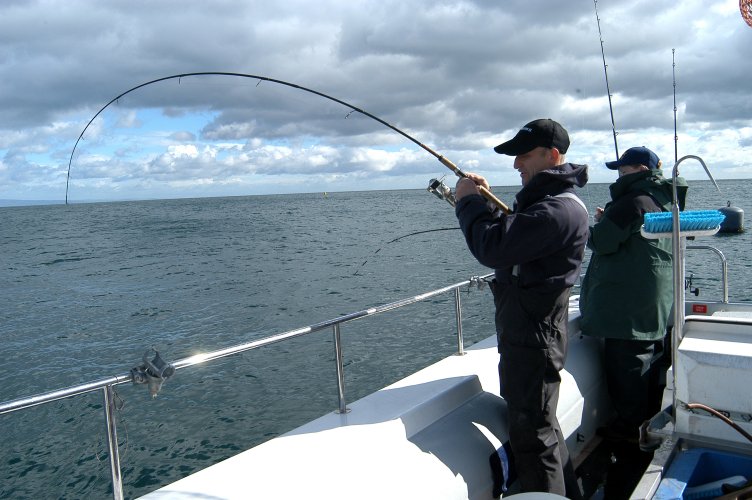
Launched from a purpose built trailer by an Isuzu pick up and driven straight back on to the trailer at the close of play, it could not be simpler. Granted, it looks odd to be trailer launching a 30 foot charter boat, and even odder to see an angling RIB coming in to the quay to pick you up. But once you get on board you would never know it was a RIB other than by the boats sheer pace, high cruising speed, stability, and comfortable ride. The interior is completely fibre glass lined – a boat within a boat. And as for puncturing the tubes with hooks or gaffs, well forget it. These are made from heavy duty pierce resistant hypalon, besides which there are 5 separate compartments within each tube.
Our original two day plan had been to have a go at everything on offer, but unfortunately the wind which was obviously throwing up quite a lively sea further offshore put paid to that. The fabulous pollack fishing to be found around Sanda Island midway between Ireland and Scotland was the first thing to be crossed off the list, though I am assured that a RIB can eat up even those sea conditions. Not as sure about the anglers though.
Fishing for common skate would also have been hard work due to the size of the tides. Neap tides fish the best. It can take as much as 3 Kg of lead to hold bottom on a spring tide, which isn’t a problem bringing back up when a ton up skate has taken the bait, but can be painful in the extreme when a bait check is called for, hence the value of whole dogfish for bait. Drifting for turbot was also going to prove difficult in the strong winds as for some reason they refuse to feed when the boat is moving along at more than 1.5 knots over the ground. We could however fish for pollack, make some sheltered drifts for haddock, and try anchoring the banks. But first off, I had an appointment I was particularly keen to keep.
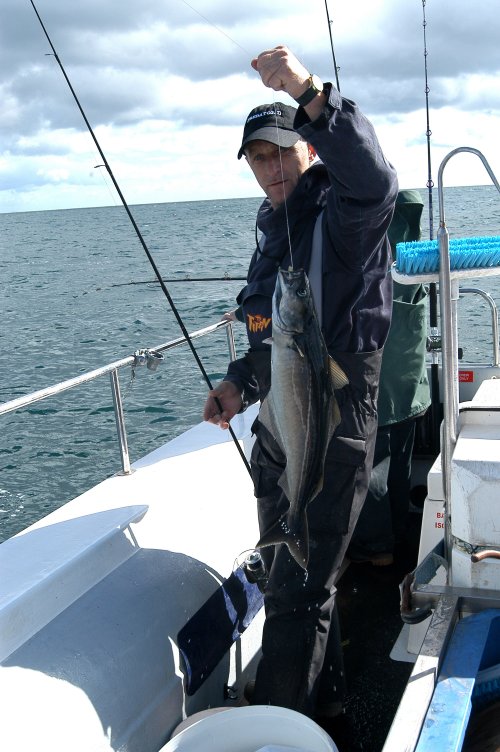
One of my un-fulfilled angling ambitions is to break a world record. Several weeks prior to this trip, I fished Scotland’s Mull of Galloway with ‘Onyermarks’ skipper Ian Burrett and fly angler Allan Everington. As part of a steady stream of fish to the fly, Allan bettered 3 tippet class world records, though no claims were made. When I spoke with Hamish about this, he told me about huge shoals of big coalfish that live around the salmon cages out in the bay. He chums them up with trout pellets then fishes ultra light rods, lead heads and jellyworms and has taken fish well into double figures.
Chumming is not permitted by the IGFA for record claims, besides which, when they were chummed up, these coalies formed a tight ball and became pre-occupied by the pellets. Tied up to the cages and with quite a lick of tide to contend with, it was easier to get a take when the chum wasn’t going in and the fish were scattered and foraging. On an 8lbs bs tippet I got smashed up several times by big fish, some of which had most of the backing off the fly reel. But I did manage to hang on to a couple of fish, and the claim has now been ratified. So for anyone interested either in world records or fly fishing at sea, Cushendall is most definitely worth a look.
From the two headlands marking the extremities of Red Bay run a series of cliffs and points stretching for many miles. To the north, Torr Head is a particularly good pollack area. The fishing all along this stretch is done tight in to the shore in around 25 to 40 feet of water with light tackle and leadheads. You can use jelly worms, but Hamish prefers long belly strips of mackerel. The pollack have taken quite a liking to these too.
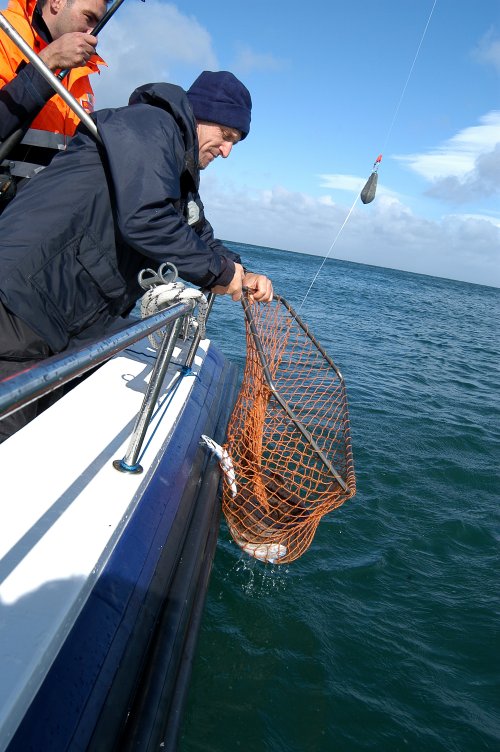
Obviously small to middle range fish out number the bigger specimens. But there are double figure fish to be had and plenty of pollack in the 6 to 7 pound bracket which give a really good account of themselves and can be relied upon when the wind is strong. Whether the tide would be too much for the fly gear is something I didn’t get to try. Off the Mull, Allan Everington used a fast sinking line. Perhaps here a lead core shooting head would give a better sink rate in the flow, though pollack are more than willing to move well up off the bottom when something they fancy goes tripping by over head.
Our next port of call was to anchor one of the banks little more than a mile or so out in the bay. With quite a lick of tide passing over it we had to use a kilo of lead to keep the baits down. Hamish has recorded some quite spectacular turbot catches here with many big fish returned while fishing at anchor. But you need a certain amount of luck as well as good skippering skills to drop the boat right on top of fish every time, unlike drifting where you are constantly covering ground and searching out pockets of fish.
There are some big blonde rays on these banks too, and what tough customers they can turn out to be, particularly when they decide to use the tide to their advantage. I hooked one good fish which was presumably a blonde ray that did just that. It was a real handful which had been pumped most of the way to the boat when suddenly it put the brakes on. Hanging in the tide, it took every ounce of muscle I could muster to try and break the stalemate. Unfortunately however, I broke the rod tip instead, and that as they say was the end of that.
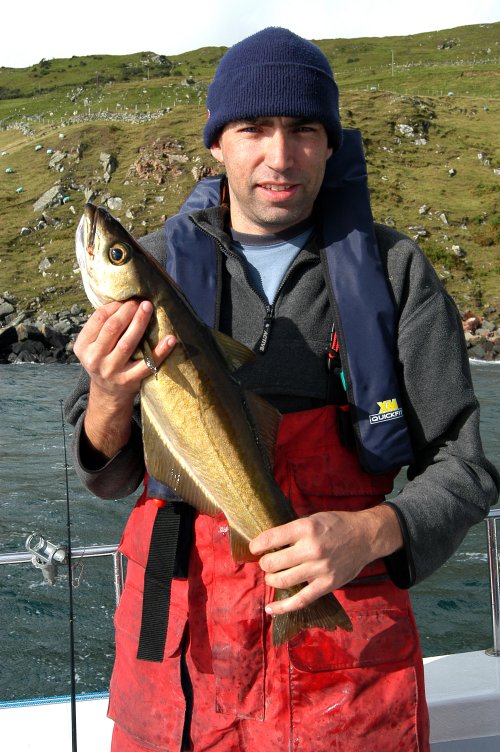
Hamish Currie comes from good sea angling stock. Both his mother, and his father Bill who I fished with back in the 1970’s, were Scottish internationals. As for his own angling CV, he has spent the past 15 years in chartering, the last 10 of which have been at Cushendall. Blonde rays to 27½ pounds, turbot to 18½ pounds, spurdogs to 16½ pounds, cod to 17 pounds, and common skate to 125 pounds all taken within 10 minutes of the quay is a pretty impressive record. Huss, dogs, conger, rays, gurnards, whiting, haddock, dabs, plaice…. the list goes on. We even had a sunfish collide with the boat.
Runs over to Sanda are a regular feature, and not only for the pollack. There are porbeagle sharks out there too, some of which have already seen the boat. Isle of Man trips for tope are another established item on the menu. And as if all of this along with heaps of shelter were not enough, boat fishing in and around Red Bay is a year round affair. Obviously, the winter species list is a little more restricted with spurdogs, common skate, pollack, and amazingly, a year round supply of fresh mackerel as the main targets. Sadly these days there are not so many big cod. Red Bay used to be alive with the things, often topping 30 pounds. If they were about now many would be going back to feed again as Hamish is very much a catch and release angler, a message he is keen to promote to those who fish from his boat.
I mentioned earlier that Red Bay was the ideal venue for a small boats competition, something I have made known to the Northern Ireland Tourist Board. Quality fish of so many species, plenty of shelter, an excellent slip adjacent to lots of secure parking with toilet facilities, good roads both sides of the water, a short crossing from Cairnryan aboard P&O ferries, excellent food at Harry’s in the town, good pubs, first class accommodation both at Cushendall and nearby Cushendun where I stayed, and lots of friendly people. What more could any dinghy angler ask for.
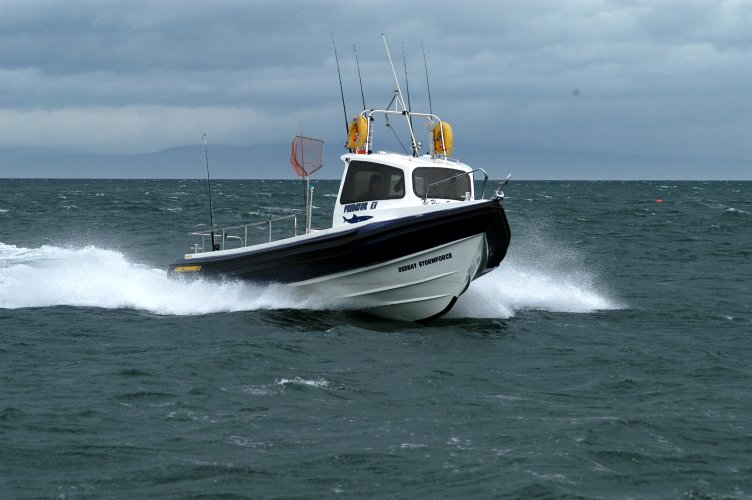
Well, one thing would be that recognition be given to the quality of what is on offer at Cushendall by the powers that be in Belfast and at the Causeway Coast & Glens Dept., along with an appreciation of how many dinghy anglers there are in England, Scotland and Wales with a track record of taking part in small boat competitions in Ireland. Good for tourism in Ireland, and a great opportunity for British anglers to sample what Northern Ireland has been keeping under wraps for itself for years. Alternatively, or in addition while over with the dinghy if the offshore stuff appeals, give Hamish Currie and Predator II a try.
INFORMATION & CONTACTS
Hamish Currie – Tel.02821 771828 or 07720 440117. www.predatorireland.com
For a free angling in Ireland information pack, call Tourism Ireland on 0845 603 0001, or log on to www.tourismireland.com
P&O Ferries www.poirishsea.com
IGFA COALFISH WORLD RECORDS ON FLY
| Coalfish | Tippet 1 Kg (2 lbs) | 1 lb 13 oz |
| Coalfish | Tippet 2 Kg (4 lbs) | 1 lb 2 oz |
| Coalfish | Tippet 3 Kg (6 lbs) | 8 lbs 14 oz |
| Coalfish | Tippet 4 Kg (8 lbs) | 1 lb 10 oz |
| Coalfish | Tippet 6 Kg (12 lbs) | 10 lbs 12 oz |
| Coalfish | Tippet 8 Kg (16 lbs) | 18 lbs 8 oz |
| Coalfish | Tippet 10 Kg (20 lbs) | 28 lbs 14 oz |